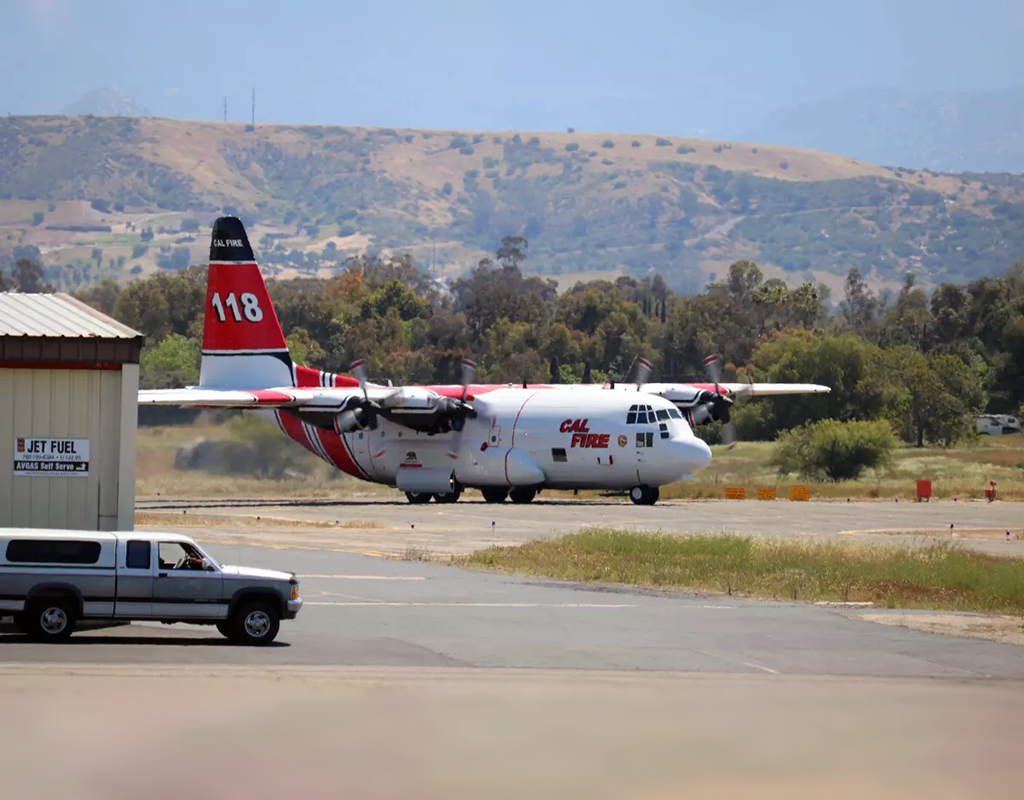
A former search-and-rescue plane for the U.S. Coast Guard will be making its new home away from the sea at Cal Fire’s Air Attack Base in Ramona.
The C-130 air tanker is one of seven that will be joining Cal Fire’s fleet of aircraft used to fight fires. These massive planes are faster and can deliver over three times more fire retardant than the two S-2T’s at the Ramona base, said Cal Fire Captain Brent Pascua.
“They can fly longer, they don’t need to land and refuel as often,” Pascua said. “They’re not replacing our S-2T’s but they’ll take some workload off them.”
A C-130 used to train pilots at the Ramona Air Attack Base in August 2019 was leased to Cal Fire on a contract basis from Coulson Aviation.
Nick Brown, aviation battalion chief at Ramona Air Attack Base, said that getting a C-130 plane in San Diego County is crucial with the region’s fire risk and past major fires like the 2003 Cedar Fire and 2007 Witch Creek Fire.
“To add a C-130, that type of tanker, is huge for us,” Brown said.
Once available, the air tankers will be able to deliver about 4,000 gallons of fire retardant. The S-2Ts can deliver 1,200 gallons. When fully loaded with retardant, the C-130 has a range of 800 miles and can be in operation for up to eight hours straight.
With the three-person crew that is dedicated to the C-130, the plane will be ready on the strip for takeoff in a short amount of time, Brown said. The downtime on the ground for refueling the retardant would only be between five and 10 minutes, according to Brown.

A C-130 plane taking off at the Ramona Air Attack Base in 2022 (CAL FIRE/San Diego County Fire)
The C-130 doesn’t have to drop all 4,000 gallons at once, Brown said, but can split it in two drops. This is useful in using the plane to attack multiple fronts of a fire at the same time, he said.
The planes have had repairs and improvements over the last several years, Pascua said.
“Not only having to repaint them into the Cal Fire paint scheme and go through the rigorous testing, we also had to install the 4,000-gallon retardant tanks,” he said. “There’s quite a bit that goes into this.”
The size and conditions around a wildfire will ultimately determine the response level and which planes will be used, Brown said. A medium-level dispatch will utilize the other planes and three helicopters, but not necessarily the C-130.
A fire in the middle of the summer in 90 degree weather with low relative humidity would most likely warrant the C-130 being sent out, he said.
These planes bring in the support needed to finish the job of putting out the fire, Brown said.
“A lot of people think it’s the aircraft that puts the fires out. It doesn’t,” he said. “It gives us the ability to slow down the fires so the ground crews can get in there and contain it.”
Having access to this plane will be a game changer, Brown said, in being able to dump over 6,000 gallons of retardant on a fire anywhere in San Diego County with the C-130 and the two S-2T’s. It’s this kind of response that could mean the difference of saving several houses from catching fire or 10 acres that would have otherwise been burned, Brown said.
In December last year, seven C-130 planes were transferred from the Coast Guard to Cal Fire, Pascua said, five of which will be dispersed throughout the state and two held back as reserves and used while one of the other five have to undergo maintenance.
The five C-130s will be placed in Chico, McClellan, Paso Robles, Fresno and Ramona, Pascua said, each place chosen strategically to support the surrounding area.
According to Pascua, test runs for the newly outfitted planes are scheduled for later this year and Ramona could see its plane as early as the end of this year, he said.
“It’s going to be impressive to see on a fire and I can’t wait,” he said. “I think this is going to be a great asset overall to the aircraft firefighting fleet.”

